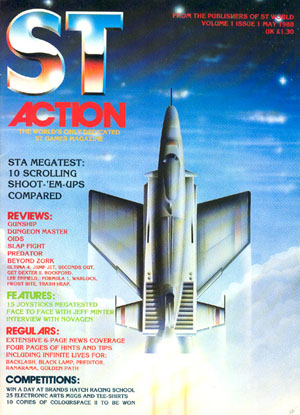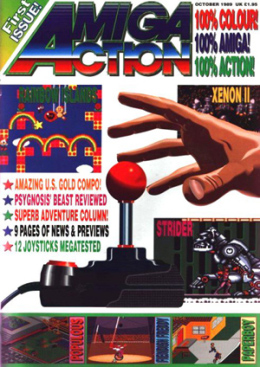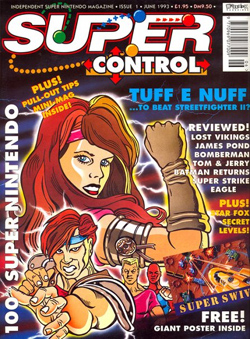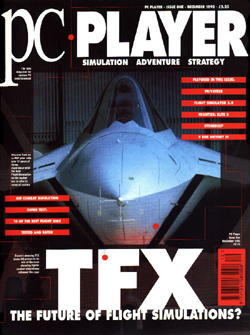|
To coincide with the “official” release of Mega Drive Advanced Gaming issue 2, here at Out-of-Print Archive, Hugh Gollner — the Launch Editor/Publisher behind the publication, as well as many others — takes time out to discuss his publishing career.
|
|
Out-of-Print Archive: Can you briefly introduce yourself?
Hugh Gollner: Just to confuse matters, when I got married to my wife Victoria, I changed my surname to her surname (yes, very modern I know!). When I published Amiga Action, ST Action, Mega Drive Advanced Gaming and the other magazines, my name was Hugh Gollner. This has had the handy side effect of making it hard for people to track me down!
OoPA: How did you initially get involved with the magazine industry?
HG: I was developing games for the Atari ST and thought it would be a good idea to start a fanzine which I could use to promote my games. The fanzine turned into a proper magazine called ST User (later ST World), and I found that more fun than writing the games.
OoPA: ST Action (launched in May 1988) and Amiga Action (launched in October 1989) were quite the trend setters for gaming magazines on the 16-bit computers, as ST and Amiga magazines up until that point were very technical orientated and often relegated games to the back of the issue or ignored them. Can you tell us a little about how these two innovative magazines started up
HG: I'm not really sure the magazines were trendsetters, although they were the first games only titles for the ST and Amiga respectively. We used to launch magazines on a whim! The guys working on ST Action kept pestering me about the Amiga and saying that it was so much better for games, and eventually I just gave in and launched Amiga Action. There was no science or clever thinking about it — we just thought “what the heck, let’s do it!” |
|
 |
 |
|
OoPA: Probably the more successful of the two 16-bit magazines — readership wise — was Amiga Action, which was the number one Amiga games magazine during the late 1980s, and outlasted Amiga Power. Do you recall any memorable highs and lows while working on the magazine?
HG: Amiga Action was only the best selling Amiga games mag for one ABC [Audit Bureau of Circulations - OoPA] period. In reality, I have to say that Future Publishing's Amiga Power was a better magazine. We just worked out that if you stuck more and more coverdisks on, then sales went up. I think we had at least three disks on at one point! But beating Future on that ABC period was probably the biggest high point. I really respected Future Publishing and especially Chris Anderson, Greg Ingham and Steve Jarratt [Future's founder, Managing Director |
| and Editor respectively – OoPA]. Future revolutionized computing magazines — they made them 'sexy' as Chris used to say. In the early days I got an offer from Chris to come and work for him — I wished I'd taken him up on it, but at the time we had debts running Gollner Publishing and his offer was not very generous. |
OoPA: So, what happened to Gollner Publishing, as I see later issues of Amiga Action and
ST Action were published by Europress Interactive?
HG: Gollner Publishing always ran at a bit of a loss, and eventually we were forced to sell out to Europress. We had some good technology and a great understanding of desktop publishing. We were one of the first publishers in the world to do all our colour production using Apple Macs, Quark Xpress and a Linotype imagesetter. So Europress were keen for us to come and help bring them into the DTP era. All the guys and girls on the magazines moved up to Stockport with me and worked at Europress for a few years. |
OoPA: Your were Launch Editor/Managing Director on Games-X, which was an ambitious weekly games magazine launched in April 1991. What was it like producing a games magazine on a weekly basis?
HG: Hard! It took a heck of a lot of work to produce that much content each week. It was very difficult finding enough good games to review each week. It was an ambitious magazine. It was also a big mistake – it lost a fortune! In fact he probably doesn’t know it, but Future’s Greg Ingham was responsible for some of the losses. He bet me £100 that the magazine wouldn’t last past Christmas (or some such date) — I was so determined to win his bet that we kept the magazine running far longer than we should. We probably lost £50k more than we should have — and in the end I never cashed Greg’s cheque (I’ve still got it!) |
|
 |
OoPA: How did Maverick Magazines Ltd come about?
HG: My relations with the other directors at Europress were never great, and loosing money on Games-X didn't help. The magazine was my idea, although to be fair when I originally conceived it, it was a low cost magazine which suffered from having four directors with big egos running it. We all had our pet marketing ideas, one of us wanted TV ads, one of us wanted to put sample copies in all our other titles, one of us wanted to do loads of market research. Each of us said, "If I can't have my way, we're not doing it". The result was that we spent far too much cash launching it. I'd had enough and decided to leave and hence Maverick Magazines was launched.
 |
|
OoPA: Can you give a quick overview of the Maverick Magazine titles?
HG: Mega Drive Advanced Gaming was, er, um, our Mega Drive magazine. This was my pet magazine and I really got on with the team who were producing it. The fact is that I didn't have such a great relationship with the Control team and I neglected it, or at least couldn't find a way of working well with the team who were producing it. We were all pretty young and didn't really know how to work well together as colleagues. Because of my relationship with the MAG team (you see what we did there with the title?), the magazine was just how I wanted it. We sold 52,000 copies of the launch issue (September 1992) without any real promotion — we were profitable from issue 1 which is pretty unusual. Unfortunately, Control |
| [later re-launched as Super Control – OoPA] had been launched too early in the Super Nintendo's life cycle (also September 1992) and so sales were much more modest (20,000 as I remember). PC Player was much later (December 1993). It was a bit of a rip-off of Edge magazine (which we absolutely loved — cannot express how much we loved it). However, it was probably the best games magazine I was involved with. For serious gamers it was just perfect — big fat, thorough reviews of serious strategy, simulation and adventure games. It was a good niche concept which was conceived by John Davison and art directed by Alex Simmons (drop me a mail if you read this guys!). |
OoPA: What did you think of these new Mega Drive and Super Nintendo consoles invading the UK and the sudden explosion of subsequent Mega Drive magazines (MegaTech, MEGA, Mega Power, Mega Action, Sega Force Mega)?
HG: The truth is I was more in love with magazines than games consoles. We had writers who were crazy about the consoles. It was an exciting time though. There were always loads of new consoles coming out and almost a new magazine each month. There were far too many magazines. Actually, although I've already said I was always in awe of Future, I didn't think MEGA was one of their best. I actually think that MAG gave them a pretty good run for their money (I think we might even have beaten them in one ABC period). |
|
 |
OoPA: Why did Maverick Magazines close?
HG: The console market used to go in big cycles and we were a victim of one of those cycles. We went on to produce a couple of motor racing magazines and then stopped publishing altogether.
OoPA: What did you do next?
HG: I didn't know what to do next. It is pretty hard running your own independent publishing company, so I thought why not give it a go at one of the big publishers.
OoPA: This was EMAP Images (publishing company of classic videogaming magazines such as C&VG, Mean Machines and Sega Saturn Magazine)? What happened at EMAP, as I believe you were there for a relatively short time?
HG: Didn't like it. Three problems. 1) It was all running smoothly and reliably (which I wasn't used to); 2) I had no experience of the corporate world; and 3) The people I was working with had wanted the job and so hated me for getting it. So I wasn't enjoying it and I left. Simple really!
 |
|
OoPA: Do you have any interesting stories or behind-the-scenes happenings while working on the various magazines?
HG: Oh, yes! One editor was fired for stealing competition prizes himself instead of sending them to readers. Someone told me and so I went round his house and saw all the prizes through the windows! One of the writers on the console magazines was given the job because he mentioned in the interview that he was good at playing pool — two hours and five pints later he had proved it at the local pub, and got the job as a result. The PR jollies were legendary — at that time being a games journo meant as much free booze as you could drink. In fact as I write I'm sitting in the kitchen of two of the PR people from that |
| era — still drinking their booze! Gremlin let us drive Lotus sports cars at 150mph, someone else organised a piss up in a Brewery. |
OoPA: Mega Drive Advanced Gaming issue 2 is being released to coincide with this interview — thanks again for your permission to work on your magazines — but are there any particular magazines that you would like to see at Out-of-Print Archive?
HG: I'm really looking forward to being able to directly compare our titles with those of Future and EMAP. With the benefit of time and distance it will be interesting to make a more impartial judgment of their strengths. What I'd love to see are issues of Dennis' Zero and Future's Total!. These were both awesome magazines. Really funny, really well designed, completely impartial reviews — I cannot stress how highly I regard these titles. |
|
 |
OoPA: What's your opinion on the current computer and games magazine industry?
HG: I don't read them anymore, so I'm completely out of touch. I do have a PS3 though, which is awesome!
OoPA: What do you think of Out-of-Print Archive and magazine preservation in general?
HG: There was so much work put into all these magazines, both by us and by publishers such as Future. Magazines are such creations that to have somebody preserve them and enable people to look back on them is great.
OoPA: So what are you up to at the moment? Are you still involved with the magazine publishing industry?
HG: Nothing to do with magazines at all. I haven't published a magazine since 1997. I'm making these insane, interactive children’s amusement machines — it’s great fun! I absolutely loved working on magazines, but I think the internet is just about killing them off. Maybe some future colour e-book reader will make it possible again for independent publishers to produce small titles — if it does then maybe I'll give it another try. There is just nothing better than producing a magazine for a month and then getting the delivery truck arriving at the door with the new edition hot of the press. Everyone sits quietly and digests it for ten minutes and then they launch into a discussion about what was good and what was bad — great teamwork!
|
|
We are working on bringing more "official" releases like this to Out-of-Print Archive, so stick around as there is plenty more to come. Why not discuss this interview in our forums.
|
|
| |
|

|
|